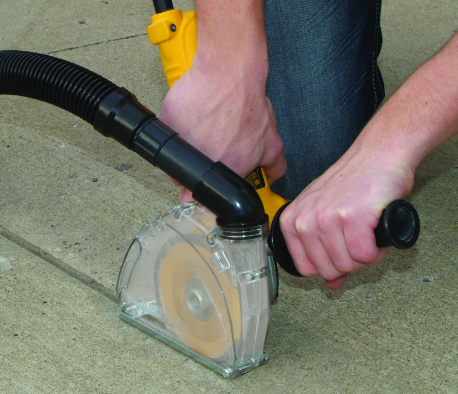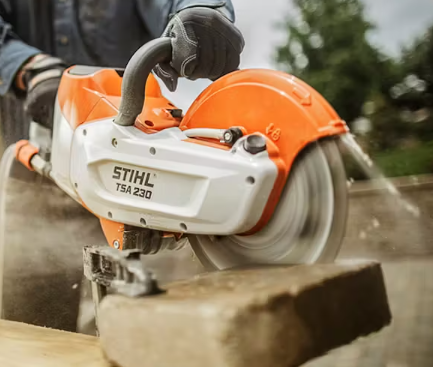Understanding Silica Dust and its Hazards
Silica is a common mineral present in materials such as concrete, sand, masonry, gravel, and rock. When these materials are cut, ground, or drilled, they produce silica dust containing crystalline silica particles. These particles are minuscule and easily inhaled. When construction operations require working around silica dust, ensuring the safety of your construction crew is vital, and that begins with educating them about the significance of silica dust safety. The long-term consequences of exposure to silica dust aspect can be severe.
The Perils of Silica Exposure
Silica dust is a fine dust classified as a human lung carcinogen, and inhaling it can inflict significant damage to the lungs. Workers exposed to silica dust inhale tiny particles that become trapped in the lungs. Exposure to respirable crystalline silica dust can damage lung tissue leading to the formation of scar tissue thereby impairing lung function. This condition is known as silicosis, and it has no cure. Silicosis can result in respiratory issues, severe lung infections, lung cancer and other health problems. Even if the effects aren’t immediately noticeable, the damage from silica dust is cumulative. The more you expose your lungs throughout your career, the greater the risk of permanent lung damage. Taking safety measures today is a proactive way to prevent future health complications.
Many Construction Materials Contain Silica
Many construction materials contain crystalline silica. Cutting, grinding and demolishing of these materials will create silica dust and nearby workers will have a high risk of respirable crystalline silica exposure. The following some construction materials commonly contain silica:
- Stone and rock, especially if the stone and rock contain quartz
- glass
- brick & block
- concrete
- sand
- grout and mortar
- drywall
- tile
- fiberglass
When working with these materials, it is important that workers be trained on the dangers of silica dust exposure and effective management of silica dust to protect themselves from long term health consequences of silica dust exposure. Construction supervisors should be aware of what upcoming activities have the risk of exposure to silica dust. When cutting or grinding is required, check to see if the material being worked on contains silica. Incorporate measures for prevention and mitigation into the planning process.
Effective Silica Dust Safety Measures
- Direct Dust Control : Employ water suppression or vacuum systems to minimize dust at its source. Wet kits can be attached to concrete saws, grinders and drills to provide water suppression at the point of contact, eliminating or reducing the amount of respirable dust produced. Vacuum systems can also be installed to provide local exhaust ventilation at the point of contact.
- Respiratory Protection: In cases where water and vacuums are insufficient, wearing a mask is crucial. OSHA-approved N-95 respirators are the recommended choice for safeguarding against silica dust. If you opt for an N-95 mask, OSHA mandates a fit test to ensure its proper functionality. These fit tests can be found online for free
- Ventilation: When working indoors or in confined spaces incorporate a ventilation system. Use fans or blowers to bring fresh air into the work area and reduce dust particles present in the work area. Use this in combination with respiratory protection and dust control at the point of contact.
- Personal Hygiene & Housekeeping: Always wash off silica dust from your hands, face, and clothing before eating or leaving the work area. Always clean the work area to wash away silica that has collected on surfaces. If this silica material dries or is disturbed, it will become airborne and can be inhaled by workers.
Remember that OSHA strictly enforces the requirements listed above. Failing to protect yourself or your coworkers from silica dust could result in long term health consequences, as well as large fines.


Recognizing Silicosis Symptoms
Silicosis is classified into three types: chronic/classic, accelerated, and acute. (credit OSHA fact sheet: https://www.silica-safe.org/know-the-hazard/body/2-OSHA-Crystalline-Silica-Fact-Sheet.pdf)
Chronic/Classic Silicosis: This is the most common form and occurs after 15-20 years of moderate to low exposures to respirable crystalline silica. Symptoms may or may not be obvious, necessitating a chest x-ray to confirm lung damage. As the disease progresses, individuals may experience shortness of breath, along with clinical signs of oxygen/carbon dioxide exchange problems. In later stages, fatigue, extreme shortness of breath, chest pain, or respiratory failure may occur.
Accelerated Silicosis: This form can develop after 5-10 years of high exposures to respirable crystalline silica. Symptoms include severe shortness of breath, weakness, and weight loss. The onset of symptoms is longer than in acute silicosis.
Acute Silicosis: This type emerges after a few months or as long as 2 years following exposures to extremely high concentrations of respirable crystalline silica. Symptoms include severe and disabling shortness of breath, weakness, and weight loss, often leading to fatal consequences.
Conclusion – Silica Dust Safety
In conclusion, understand silica dust workplace exposures and implement silica dust safety measures to safeguarding the health and well-being of construction workers. Prioritizing safety today ensures a healthier and more productive workforce in the future. Make silica dust safety a core value in your organization to protect your yourself and coworkers.
Remember, an investment in safety today secures a brighter, healthier, and more efficient workforce tomorrow.
